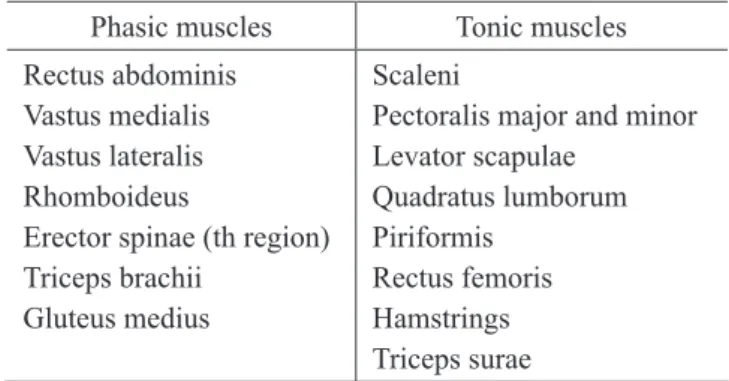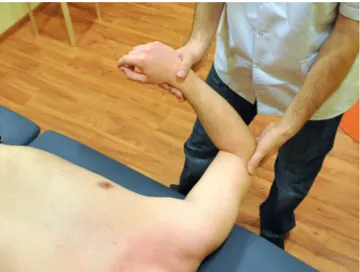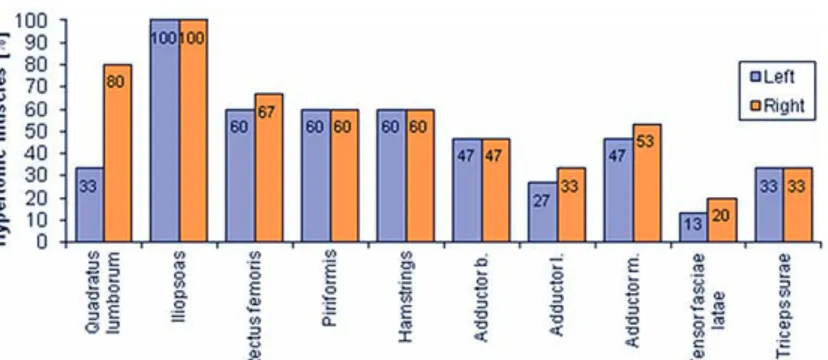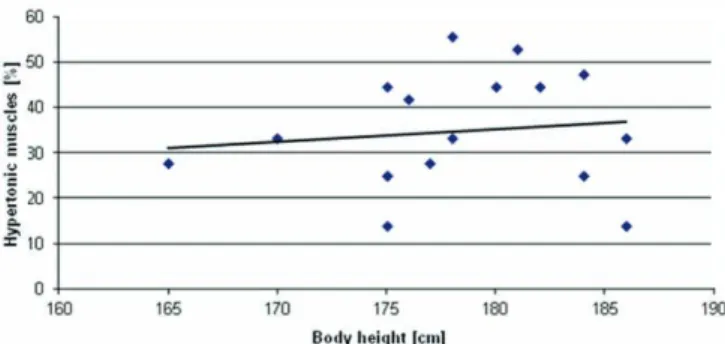ORGINAL PAPERS
TRENDS in
Sport Sciences
2013; 4(20): 181-187.ISSN 2299-9590
An analysys of muscle balance in professional fi eld
hockey players
KRZYSZTOF KAWAŁEK 1, TOMASZ GARSZTKA 2
Introduction. The purpose of practicing sport is to improve one’s physical fi tness and technical skills. Highly specialized training strengthens particular muscles, which due to repeated overuse may become hypertonic and shortened. This kind of disorder of soft tissues surrounding joints limits the articular range of motion and causes pain, which in effect reduces an athlete’s ability to compete. Aim of Study. The aim of this study was to evaluate the state of muscle balance in fi eld hockey players. The research sample consisted of seventeen professional players from the Polish National Field Hockey Team from 2009. Material and Methods. The research methods included muscle length tests and a questionnaire survey on players’ pain symptoms and their knowledge about maintaining muscle balance. Results. Insignifi cant asymmetric muscle balance disorders were found in the upper limb region. The external rotators of the shoulder joint were the most overused muscles. Signifi cant symmetric muscle length disorders were found in the lower limb region – the iliopsoas was shortened in 100% of cases, and rectus femoris in 63%. Conclusions. Several conclusions were drawn. The most signifi cant one is that all fi eld hockey players exhibit disturbances in muscle length and suffer pain. This research shows which muscles are highly overloaded and should be taken into consideration in developing programs of stretching exercises. To improve the effi ciency of these exercises they should be supervised by an experienced physiotherapist.
KEY WORDS: fi eld hockey, muscle balance, overuse, stretching, pelvic crossed syndrome, muscle lenght, muscle tests.
Received: 17 July 2013 Accepted: 22 November 2013
Corresponding author: krzys.kawalek@gmail.com
1 The Józef Rusiecki College in Olsztyn, Poland, Faculty of Physiotherapy
2 University School of Physical Education, Poznań, Department of Racket Sports, Poland
Introduction
H
uman muscles work to move bones, maintain the vertical posture and stabilize some segments of the biomechanical chain to allow other segments to move. Therefore, from the kinematic point of view, muscles perform entirely different roles – they move and stabilize segments. Considering their functions in biomechanical chains we can divide them into phasic and tonic muscles [1]. Phasic muscles perform dynamic and isotonic activities. They produce high strength values in short time, tire fast and regenerate long. Tonic muscles perform the static and isometric function, e.g. maintaining the vertical posture or muscle tone even during sleep. Contrary to phasic muscles, they do not require much oxygen and nutrients, regenerate faster, and are, therefore, adapted to long-term and low-effort activities. Examples of phasic and tonic muscles are listed in Table 1.Maintaining balance between both groups of muscles is essential to perform a movement with utmost precision and speed as well as with low energy output. This balance can be disturbed by professional and highly
What is already known on this topic?
There have been scientifi c studies that prove structural degenerative changes in intervertebral and knee joints of fi eld hockey players. However, there has been no complete functional analysis that could defi ne muscles that tend to be overused and should be taken into consideration during stretching exercises.
specialized sports training, because of repeated and specifi c muscles overuse. In athletes practicing sports requiring quick reactions, including field hockey, exaggerated spine curvatures have been observed [2]. A lumbar hyperlordosis can be caused by overusing the hip joints, as they are strongly connected with the spinal and knee joints [3]. An example of hip muscles affecting the lumbar spine is the pelvic crossed syndrome, where tonic hip fl exors together with lumbar extensors are signifi cantly stronger than the phasic hip extensors and abdominal muscles [1, 4].
An increased lumbar lordosis causes pain and structural changes in the lumbar-sacral region, e.g. degeneration in intervertebral joints and discs [5, 6, 7, 8].
Aim of Study
The aim of this study was to evaluate the state of muscle balance and the frequency of pain symptoms in athletes practicing a quick, resistance sport, i.e. fi eld hockey. Material and Methods
The research sample consisted of seventeen fi eld hockey players from the Polish National Team aged from 22-35 years, who had trained fi eld hockey from 10 to 27 years. All the players were right-handed. In the 2008/2009 season they played for Polish sports clubs (in the 1st, 2nd and 3rd places in the Polish Championships) and foreign clubs. The characteristics of the subjects are given in Table 1. Study results were collected from a survey and functional tests of muscle length by Zembaty. The tests assessed the range of motion, muscle tension and players’ feelings during passive and isolated muscle stretching [9]. The tests were performed to assess whether muscles have a normal length or not. The evaluation was conducted after a regular season and before an international season in the morning hours, with no warm-up, in comfort temperature.
Thirty six muscles (eighteen for each side of the body) were evaluated and they are presented in Table 2.
The applied muscle tests are presented below: • Latissimus dorsi muscle test (Fig. 1).
Starting position: a patient lies supine, lower limbs fl exed in the hip and knee joints, the tested arm is fl exed over 90° and maximally rotated outwards. A therapist stands on the tested side.
Performance: the therapist stabilizes the patient’s rib cage on the tested side with one hand and performs a maximal fl exion of the patient’s arm.
Interpretation: a range of motion less than 180° confi rms muscle shortening.
• Shoulder external rotators test (Fig. 2).
Starting position: a patient lies supine. Tested upper limb abducted to 90° in the shoulder and fl exed to 90° in the elbow.
Performance: a therapist rotates the patient’s shoulder internally. Stabilizing the scapula is necessary – it cannot stand out from the surface of the postural rehabilitation table.
Interpretation: a range of motion below 85° indicates muscle shortening.
• Iliopsoas muscle test (Fig. 3).
Starting position: a patient sits at the edge of the table holding the non-tested thigh close to his chest. Performance: the patient lies down on the table holding the non-tested lower limb, while the tested lower limb hangs freely.
Interpretation: the tested thigh should be about 5° below the horizontal line.
• Quadratus lumborum muscle (Fig. 4).
Starting position: a patient stands straight. A therapist stands behind the patient.
Performance: the patient performs bends to both sides. To eliminate additional movements (fl exion or extension of the trunk) the patient is asked to move the hand along the thigh.
Interpretation: the range of motion is measured (it should reach about 9 cm between the fossa axillaris and the top of iliac crest) together with the symmetry of adipo-cutaneus folds on the contralateral side.
Results
The data collected from the survey revealed that fi eld hockey players do not know the purpose of stretching exercises and how they should be executed during the training. The majority of players (70%) perform these exercises at the beginning and at the end of a training session. Other players perform them only at the beginning (24%), or only at the end of training (6%). It is worth noticing that different answers were collected from players from the same sport clubs. It is also essential to highlight that all players confi rmed that stretching was performed individually, and 35% were not able to defi ne its purpose.
A quantitative analysis of the collected data showed that 35% of tested muscles (ranging from 14 to 56%) were hypertonic (Fig. 5). There were significant differences between players of different formations (Fig. 6): midfi elders had the highest number of hypertonic muscles (47%) and goalkeepers the lowest (19%). This is probably caused by the completely different tactical
Figure 2. Final position in the external rotators test
Figure 3. Final position in the iliopsoas muscle test
Figure 4. Final position in the quadratus lumborum muscle
tasks of goalkeepers, and therefore, by their lower physical activity during training and matches. For this reason, goalkeepers were not taken into consideration in further analysis. Significant differences were noted between players from different clubs. The highest number of hypertonic muscles was found among players from the club ranked 3rd in the Polish
Championships, and the lowest among players from foreign clubs (Fig. 7).
A qualitative analysis illustrated a notably higher number of hypertonic muscles in the lower limbs. In the upper limb region the prevailing muscle disorders were observed in the external rotators of the shoulder joint (57%) and latissimus dorsi muscles (50%). No disorders were found in the biceps, internal rotators and two parts of the pectoralis major. A tendency to increase the number of hypertonic muscles in the dominant hand-side can be observed, and it is especially noticeable in the external rotators of the arm – the ratio of dominant to non-dominant side being 87% to 27%, respectively (Fig. 8).
In the lower limb region, the hypertonic state was found in each muscle. The iliopsoas muscle was the most overused muscle – it was shortened in 100% of the cases. Unlike the upper limbs, the lower limbs present symmetric disorders – the difference between sides is 6-7%. The only exception is the quadratus lumborum muscle, where the ratio of dominant to non-dominant side is 80% to 33%, respectively (Fig. 9).
A further data analysis revealed a relationship between years of practice and the number of hypertonic muscles – the longer a player trains, the less overused muscles he has.
Connections between the number of hypertonic muscles and body build were also analyzed. More hypertonic
Figure 5. Number of hypertonic muscles in players and the
mean value
Figure 6. Number of hypertonic muscles in fi eld hockey
players with regard to their playing formations
Figure 7. Number of hypertonic muscles in players from
different clubs
Figure 8. Hypertonic muscles of the left and the right side in
the upper limb region
Figure 9. Hypertonic of the left and right side in the lower
limb region
Figure 10. The relationship between years of fi eld hockey
muscles were observed in taller players, however, the difference was non-signifi cant and there was no connection to body weight (Fig. 11-12).
Discussion
The analysis of collected data showed that the mean of 35% of hypertonic muscles was noted among field hockey players of the Polish National Team. A connection between the ranking place of the sports club in the Polish Championships and the number of hypertonic muscles in players was observed: the lower the ranking place of the club, the more hypertonic muscles can be found in the club players. The lowest mean value was observed in players from foreign clubs; however, players from the 1st and 2nd teams had their mean value higher only by 5%.
Differences in the number of hypertonic muscles between playing formations were also analyzed. It was discovered that defenders had the least overused muscles. They also covered the shortest distance and reached the lowest speed during matches and training, therefore, their muscles were not intensely overused [10]. However, the physical loads of midfi elders and forwards were not proportional to the number of their
Figure 12. The relationship between body weight and number
of hypertonic muscles
Figure 11. The relationship between years of training and
number of hypertonic muscles
hypertonic muscles. It could be suggested that a forward should present the highest number of overused muscles due to the covered distance and reached speed. The research disproved that suggestion. The highest number of hypertonic muscles was observed in midfi elders. It can be caused by the fact that two highest individual values were noticed in midfi elders from the 3rd club in the championships list, which raised the mean value of this formation. It should be emphasized that the lowest individual value (14% of hypertonic muscles) was obtained by the forward from the 1st club – the most physically demanding position on the fi eld. This state of muscles can be explained by the time dedicated by the forward to stretching exercises – from 11 to 30 minutes. Moreover, players from the 1st club (unlike the other players) could regularly visit a physiotherapist and use hydrotherapy during the whole season, which strongly affected their results in the present study.
The analysis of the upper limb region showed signifi cantly low and asymmetric disorders in muscles. It is probably caused by the characteristic style of holding the hockey stick – the right arm has to be positioned in external rotation during dribbling, and the external rotators have to decelerate the arm at the end of the swinging phase after hitting the ball as well.
The lower limb region can be characterized by signifi cant and symmetric muscle disorders. The most overused muscle is the iliopsoas, which was shortened in all examined players. This was probably caused by the function of this muscle, i.e. fl exion, adduction and external rotation of the hip and forward tilt of the pelvis. The short hockey stick forces players with ball possession to maintain the balance between the lower limbs joints and intervertebral joints. Moreover, when a player runs straightened up, the iliopsoas works dynamically. These situations cause that iliopsoas is overused in two ways: isometric and isotonic, resulting in a higher tendency to become hypertonic.
A shortened iliopsoas muscle is a serious problem because when a player moves on the fi eld or during daily activities in an upright position, this limits the extension in the hip joint and provokes a lumbar hyperlordosis. This is a biomechanically unfavorable situation for spinal segments from L4 to S1 – a higher pressure of gravity force affects the posterior aspect of the vertebral bodies and intervertebral discs leading to structural damages [8]. Moreover, the intervertebral discs are also overused during the game when the player is in a bent position. The nucleus pulposus moves in the opposite
direction to the movement of the spine. During fl exion, for example, an increased pressure in the frontal aspect of the disc pushes the nucleus pulposus backwards. It presses on the anulus fi brosus, causing its rupture, i.e. slipped disk [7].
Other overused muscles include the rectus femoris, piriformis, hamstrings and adductors (with disorders ranging from 47% to 63%). Signifi cant differences were observed only in the quadratus lumborum muscle. Again, it is caused by the position that players have to maintain during the game. Flexion and side bending to the right are forced by the length of the hockey stick and the fact that the right hand is positioned lower than the left hand.
All presented overloads of the spine cause structural damage, which has been proven by magnetic resonance imaging. 68% of fi eld hockey players of the Polish National Team sustained damage of their intervertebral discs from L1 to L5, and 36% had degenerative changes in the vertebral bodies [11]. It was also observed that players who trained hockey for longer (over 14 years) sustained more severe damage.
47% of the players reported low back pain symptoms, which lasted from several days to as long as 10 months. Half of them had never gone to a doctor or a physiotherapist. Moreover, they were still practicing, without having a break for total recovery. It should be underlined that a long-lasting functional disorder leads to previously mentioned structural changes which exclude an athlete from playing for much longer time dedicated to treatment, often of surgical type.
The present study found that players who played fi eld hockey longer had fewer hypertonic muscles. This could suggest that more experienced players know how to protect their muscles. The studied players trained fi eld hockey for 10-27 years. Only one player out of seven practicing no more than 20 years did not know the purpose of stretching exercises. On the other hand, in the group of players training hockey for longer than 20 years, fi ve players out of ten did not know this purpose. It is surprising then how more experienced players who are unfamiliar with the purpose of stretching keep their muscles in a satisfactory condition.
The research data analysis demonstrated that taller players had more hypertonic muscles. It can be explained by the length of the hockey stick, which is 36.5-38.5 inches. A taller player has to perform further fl exion of the vertebral and lower limb joints to control the ball more accurately. Maintaining this position demands
larger isometric muscle activity, which leads to muscle overuse and shortening.
Conclusions
Shortened muscles lead to disorders of muscle balance in one or several joints (e.g. intervertebral joints). This muscle imbalance causes unequal tension of tissues surrounding the joints and induces pain, which limits a player’s abilities to compete during training or a match. Therefore, from the coach’s point of view, in order to maintain the proper muscle balance in players, it is a priority to train them effectively.
The following observations can be made on the basis of results of the present study:
1. In the upper limb region, 50% of the investigated muscles were hypertonic, with a right – hand side bias.
2. In the lower limb region, all the investigated muscle groups were hypertonic symmetrically.
3. In the studied group, the state of disordered muscle balance was connected with the position on the fi eld: it was higher for taller players, and lower for more experienced players.
4. Field hockey players are exposed to a signifi cant number of muscle disorders – 12 out of investigated 36 muscle groups were hypertonic in more than a half of studied players. These muscles have to be particularly considered during stretching exercises.
5. Stretching exercises controlled by a physiotherapist and using relaxing procedures help to maintain proper muscle balance.
References
1. Chaitow L, Walker Delany J. Clinical application of neuromuscular techniques. Churchill Livingstone, China. 2002; 31-72.
2. Zeyland-Malawka E. Effects of prolonged sport training on the sagittal shape of the spine. Biol Sport. 1989; 6(3): 255-260.
What this study adds?
The presented results show that lower limb muscles are strongly overused by fi eld hockey players who do not realize the importance of muscle stretching. Therefore, fi eld hockey players and coaches should be informed that maintaining muscle balance, especially around the hip joints, protects the lumbar spine and consequently improves sport skills.
3. Frost DM, Beach T, Fenwick C, Callaghan J, McGill S. Is there a low-back cost to hip-centric exercise? Quantifying the lumbar spine joint compression and shear forces during movements used to overload the hips. J Sports Sci. 2012; 30(9): 859-870.
4. Kruse D, Lemmen B. Spine injuries in sport of gymnastics. Curr Sports Med Rep. 2009; 8(1): 20-29.
5. Jentzsch T, Geiger J, König MA. Werner CM. Hyperlordosis is associated with facet joint pathology at the lower spine. J Spinal Dis Techn 2013 Date of Electronic Publication: 2013 Sep 27.
6. Keorochana G, Taghavi CE, Lee KB, Yoo JH, Liao JC, Fei Z, Wang JC. Effect of sagittal alignment on kinematic changes and degree of disc degeneration in the lumbar spine: an analysis using positional MRI. Spine. 2011; 36(11): 893-898.
7. Ogurkowska MB. Pathological changes in lumbar-sacral intervertebral discs in professional rowers. Biol Sport. 2007; 24(4): 375-388.
8. Roussouly P, Pinheiro-Franco JL. Biomechanical analysis of the spino-pelvic organization and adaptation in pathology Eur Spine J. 2011; 5(20): 609-618.
9. Zembaty A. Kinezyterapia (Kinesiotherapy), vol. I. Kasper, Kraków: 2002.
10. Konarski J. Characteristics of chosen parameters of external and internal loads in Eastern European high level fi eld hockey players. J Hum Sport Exerc. 2010; 5(1): 43-58.
11. Bartkowiak P, Lewandowski J, Szulc P. NMR evaluation of the injuries to the knee joint and vertebral column lumbar segment in fi eld hockey players of the Polish National Team The Human is the Measure of All Things. Tower Press, Sopot: 2006; 314-317.



